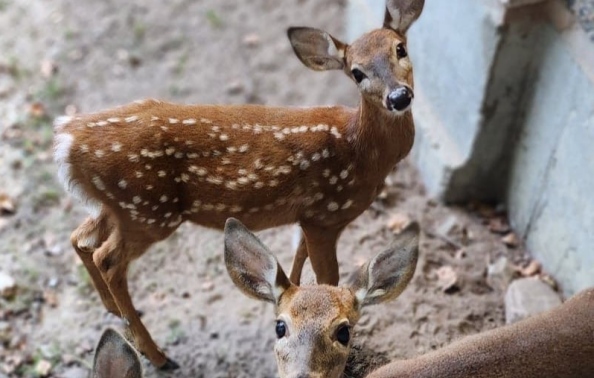“The Buttonwood Park Zoo, true to its long history of providing a home to non-releasable, rehabilitated wildlife, welcomed 3 female white-tailed fawns to its existing herd this summer.
The three young females, or does, came to BPZOO thanks to a strong partnership with the Massachusetts Division of Fisheries and Wildlife, or MassWildlife. This is the second time in two years that orphaned fawns have been placed at BPZOO.
BPZOO Director Gary Lunsford is extremely proud of this relationship with MassWildlife, as it appeals directly to his passion for local conservation – especially when it includes rescuing and rehabilitating wildlife.

Buttonwood Park Zoo photo.
“I see so much potential for BPZOO to contribute to our local conservation efforts, including providing a forever home when release isn’t an option. Having tangible impacts on the lives of animals is one of the most rewarding outcomes of zoo conservation efforts.”
The three fawns, now affectionately referred to as Annabelle, Acorn, and Thistle, were only weeks old when they arrived at BPZOO and required hand-rearing by animal care staff. After completing their required quarantine, the fawns recently began exploring their temporary habitat near their future home in the Zoo’s roughly ½ acre pasture. The three youngsters will eventually share that space with fellow white-tailed deer Autumn and Olive and approximately 16 species of waterfowl.
And while this story ends as a happy one, the circumstances under which two of the fawns came into human care could have easily been avoided. MassWildlife offers extensive information on their website about what to do if you encounter a fawn in the area that you believe might be in trouble.
“The number one thing to remember is to leave the fawn where it is,” says Lunsford. “It may look scared, weak, or vulnerable, but it is likely exhibiting typical fawn behaviors. If you have any questions at all, you can visit MassWidlife’s website, or give them a call and let them reassure you.”

Buttonwood Park Zoo photo.
According to a post on Mass.gov, if you have briefly interfered with a fawn, there are immediate steps that can be taken to rectify the situation.
“If you have taken a fawn into your care, you should immediately return it to where you found it, or to safer cover nearby (within 200 yards),” the post reads. “Then, quickly leave the area to ensure the fawn doesn’t follow you and so the mother feels safe enough to return. The mother will soon return to nurse the fawn, even after it has been handled by humans.”
About White-tailed Deer
White-tailed deer can survive in a variety of terrestrial habitats, from the big woods of northern Maine to the deep saw grass and hammock swamps of Florida. Ideal white-tailed deer habitat would contain dense thickets (in which to hide and move about) and edges (which furnish food). White-tailed deer fawns nurse for 8 to 10 weeks before they are weaned. Young males leave their mother after one year, but young females often stay with their mother for two years. Nervous and shy animals, white-tailed deer wave their tails characteristically from side to side when they are startled and fleeing. They are extremely agile and may bound at speeds of up to 30 miles per hour. White-tailed deer are also good swimmers and often enter large streams and lakes to escape predators, insects or to visit islands.”
 New Bedford Guide Your Guide to New Bedford and South Coast, MA
New Bedford Guide Your Guide to New Bedford and South Coast, MA








